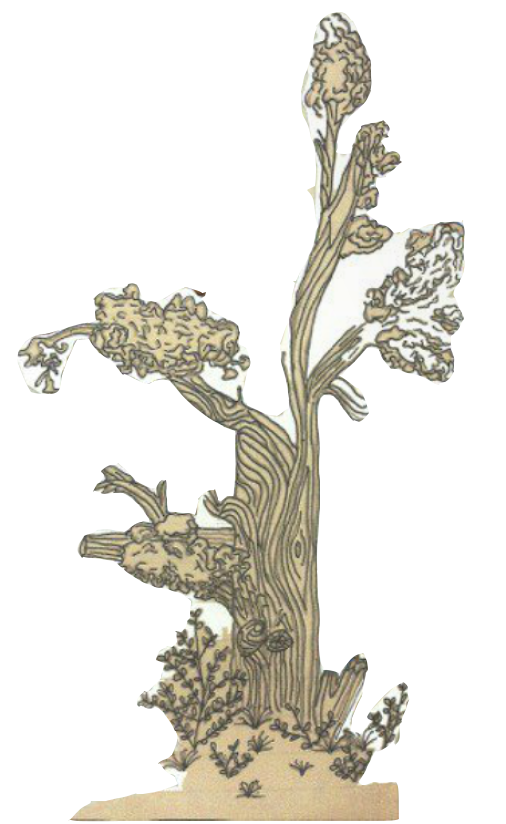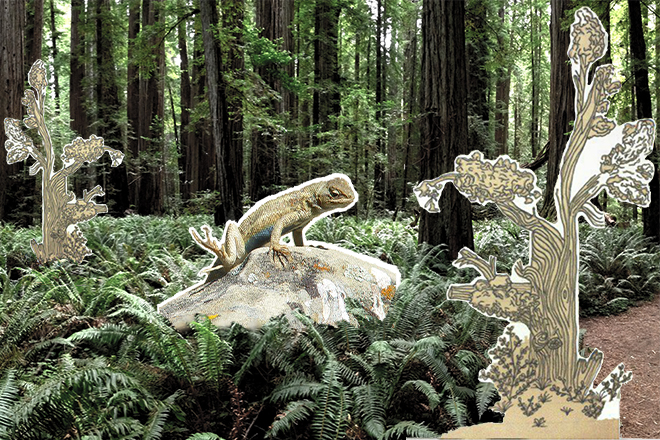
A British documentary crew found Dede Koswara’s picture on the Internet, probably in a slideshow of images called “You Won’t Believe It Until You See It.” Dede’s body was so extraordinary that the reporters flew out to his fishing village in Indonesia to film him in person. They named him “Treeman.”
Treeman is struggling from a case of common warts, the documentary reports, growing out of control because of an extreme immune deficiency. The camera pans over his arms and legs, unrecognizable under a twisting, bark-like mass of brown tubers. His face and torso are a tapestry of knobs. They film Treeman as he lumbers through crowded city streets out to the jungle, as if to suggest this is where he truly belongs. The documentary narrator says Treeman cannot be a real father with branches instead of hands and roots instead of feet.
Dede says he just wants to feel again. He peers at the camera through eyes half-closed by warts from his stoop. He sits there most of the day, too heavy to move, his hands bigger than catcher’s mitts and his feet larger than clown shoes. The dust fades around him. He blends into his wooden perch.
Before the warts, Dede made his living as a carpenter. One day, as he was walking in the forest, he cut his knee. The opening in his skin allowed the disease in, and in the cut’s place, a single wart burst forth. Over ten years, the warts multiplied. Dede became increasingly homebound as the warts limited the use of his hands and feet until, finally, Dede’s wife left him. She said it was because he could no longer work to support their family, but the process of turning skin to wood also gave off a nasty odor. Dede joined a freak show to make money, where he just stood still before a crowd every night.
The Indonesian government’s medical insurance allows Dede access to occasional surgical procedures. After doctors removed twelve pounds of warts from Dede’s body, cameras pressed against the window of his recovery room. They photographed Dede’s body lying diminished under stiff, white sheets, the shorter horns on his legs and arms sharp against a paper gown. Dede sips Jell-O through a straw. He winces as he tries to use his fingers, still covered in lichen. The warts begin their rebirth. He shifts, quarantined.
In the redwood forests on Mt. Tamalpais in Northern California, fungi often grow on dying or stressed trees. During the winter rain, the fungi blooms like the ruffles on a woman’s dress hundreds of feet into the air, slowly returning the behemoths to the dirt.
My grandparents’ closest neighbors for fifty years were redwood trees. They lived up high in a canyon on Mt. Tam and their wooden house was built around a family of redwood trees, their roots grown in a circle together. In the 1990s, as I was learning to walk on the slippery brown carpet of leaves in their front yard, scientists began tracking an unprecedented infestation of a fungal disease called “sudden oak death” in trees along the California coast. In 2002, researchers from UC Berkeley and UC Irvine found the fatal disease in trees in every California county they checked. When my brother and I roamed the forest and sent bark boats down the creek, we sometimes played in sickly shade.
At about the same time the sudden oak death fungus attacked the trees of Northern California, my body attacked itself. Red and white scales piled on my knees and scalp, and then my elbows and torso. My dermatologist told me when I was six that the psoriasis came because my immune system thought it was under siege. It built up extra layers of skin for protection for whatever might come. At least this is what leading researchers believe; but not that much has been conclusive in psoriasis research. The only thing that is clear is that it is chronic, that I cannot hope to cure it.
I told her, no, it was not terminal; it was only a genetic, autoimmune skin disorder. But yes, I said, I was going to die.
For years, disgusted classmates would ask if it was contagious, in that loud voice elementary school students use when they want their question sound like a statement.
I began wearing long shorts to hide my reptilian skin. By the age of eight, I had taken steroid creams and pills from a Western doctor. By twelve, I had tried removing wheat from my diet, then dairy, then chocolate and caffeine. I took a tablespoon of fish oil every night, with ice cream to mask the awful slippery eel flavor. By fourteen, when nothing had worked and the stress of a dying grandfather doubled the psoriasis coating my torso, I began taking Chinese herbs and acupuncture from an Eastern doctor. The more stress I felt about returning my skin to its “natural” form, the further scales crept over my body.
When I was in the fourth grade, a first grader asked if the flakes on my knees would make her sick. I told her that the disease was terminal, that I had only six months to live. She told my teacher, who called me to her desk. I told her, no, it was not terminal; it was only a genetic, autoimmune skin disorder. But yes, I said, I was going to die.
Dede is now a natural man thrown into an unnatural struggle. The Indonesian government and an expert dermatologist from Maryland are at an impasse in the fight over the medical fate of Treeman, and so Dede has been denied comprehensive surgical treatment. Instead, he is forced to undergo major surgery every year. These surgeries do nothing to address the infection running rampant across his body or his extraordinarily weak immune system. After every procedure, the warts come back faster.

Dede spends his weeks transplanted in and out of a sterile hospital room. The swarm of cameras rarely leaves his side. The resulting pictures that surface of Treeman on the Internet are often labeled “disturbing.” In one such photo, Dede lounges on the grass in a bright, jungle clearing. A small smile lights his face, his hair long and sun-streaked. His eyes are warm and accepting. He is alive, despite the new circus that surrounds him, a circus fascinated with his slow destruction, wary of his proximity to the earth.
Public opinion finds fungi on trees alluring. The U.S. National Park Service describes the beauty of the redwood trees in their parks, including the park on Mt. Tam, as “immense, ancient, stately, mysterious, powerful.” They thank the resilient nature of the redwood trees for contributing to a “verdant array of greenery, fungi, and other trees” that delights thousands of park visitors every year.
But I do know what it means to have a beauty that feels it is always hinging toward decay. I know I must see that decay as beautiful.
Peter Essick, a National Geographic photographer, paid tribute to Ansel Adams in a 2014 book. His book featured stunning portraits of the California wilderness destined for coffee tables collections across America’s upper-middle class. His acclaimed photographs included the subjects of high mountain lakes, snowcapped peaks, and fungi growing from trees. In black and white, the fungi reach boldly toward the sun, some large and globular, others thin and rippling, and most glittering like the rings of Saturn in marvelous detail.
I read about Dede’s story last year. At the time, the same part of my ego that told my fourth grade teacher I was going to die, as if I was the first ten year old to truly comprehend my mortality, burst forward. I believed that I knew what Treeman felt like. Of course I could not. In that moment, I thought for a second I was Lizardwoman. I am not. I can walk and talk and see and work. I most likely will never be relegated to a side-show. I have never been a subject of a documentary.
But I do know what it means to have a beauty that feels it is always hinging toward decay. I know I must see that decay as beautiful.
“It is unlikely that Dede will ever be completely cured of his wart virus infection,” said his expert dermatologist from Maryland. “Our goals are to better control the infection, improve his appearance, and his ability to move his hands, and thus improve the quality of his life.”
No other news on Dede’s current condition has escaped the Indonesian jungle, and when I search for him online I struggle to keep my eyes steady on his grotesque image. I worry about him sometimes. He has served to me primarily as a reminder that things could always be worse. But sometimes, in sneaking moments, he also reminds me that maybe I shouldn’t want to get better. I think of the basic state of humans — naked, grounded, degeneration and growth locked in tandem — and I think of Dede smiling in the sunlight.

I have begun to find relief for my psoriasis through light therapy. After a prescription from my third dermatologist, a medical equipment supplier sent me two boxes of light. One is a light wand with a comb attachment; the other is a black box with three fluorescent tubes. Every other day, I sit on a stool in front of my mirror with red protective goggles strapped around my head and I comb light through my hair. I stand and slowly swivel in front of the box. The lights have timers, so I move in 45-second increments. It’s working, just a little bit.
Real sunlight works better. In summertime, or on warm days, I lie naked on my deck and watch the sun soothe my scales away. Comforted by the baking tile beneath me, the real warmth breathes away the stress of trying to cure a stress-related disease. Beneath the summer rays, my body can absorb the energy of the sun — ultraviolet type B, the dermatologist said — and use it to slow the growth of the affected skin cells. The sun is healing my body. My body needs the sun. The way I see it, my limbs are learning photosynthesis.